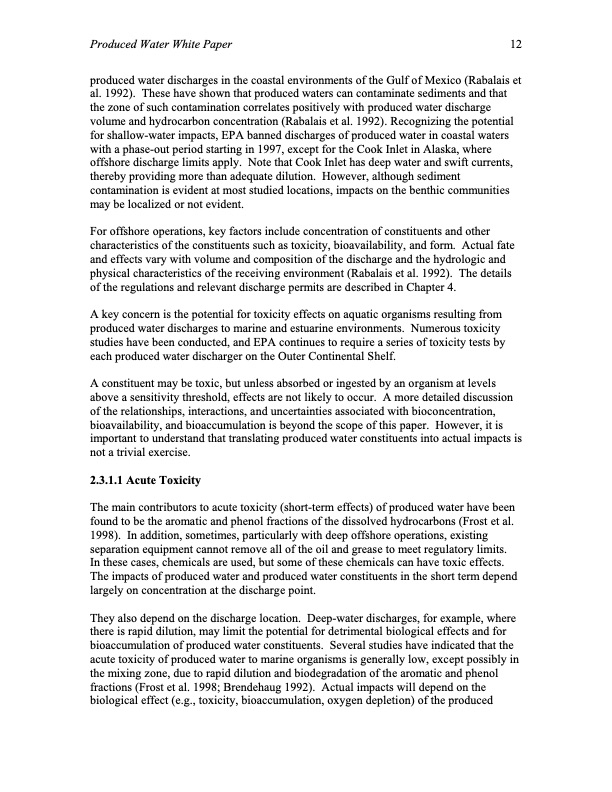
PDF Publication Title:
Text from PDF Page: 020
Produced Water White Paper 12 produced water discharges in the coastal environments of the Gulf of Mexico (Rabalais et al. 1992). These have shown that produced waters can contaminate sediments and that the zone of such contamination correlates positively with produced water discharge volume and hydrocarbon concentration (Rabalais et al. 1992). Recognizing the potential for shallow-water impacts, EPA banned discharges of produced water in coastal waters with a phase-out period starting in 1997, except for the Cook Inlet in Alaska, where offshore discharge limits apply. Note that Cook Inlet has deep water and swift currents, thereby providing more than adequate dilution. However, although sediment contamination is evident at most studied locations, impacts on the benthic communities may be localized or not evident. For offshore operations, key factors include concentration of constituents and other characteristics of the constituents such as toxicity, bioavailability, and form. Actual fate and effects vary with volume and composition of the discharge and the hydrologic and physical characteristics of the receiving environment (Rabalais et al. 1992). The details of the regulations and relevant discharge permits are described in Chapter 4. A key concern is the potential for toxicity effects on aquatic organisms resulting from produced water discharges to marine and estuarine environments. Numerous toxicity studies have been conducted, and EPA continues to require a series of toxicity tests by each produced water discharger on the Outer Continental Shelf. A constituent may be toxic, but unless absorbed or ingested by an organism at levels above a sensitivity threshold, effects are not likely to occur. A more detailed discussion of the relationships, interactions, and uncertainties associated with bioconcentration, bioavailability, and bioaccumulation is beyond the scope of this paper. However, it is important to understand that translating produced water constituents into actual impacts is not a trivial exercise. 2.3.1.1 Acute Toxicity The main contributors to acute toxicity (short-term effects) of produced water have been found to be the aromatic and phenol fractions of the dissolved hydrocarbons (Frost et al. 1998). In addition, sometimes, particularly with deep offshore operations, existing separation equipment cannot remove all of the oil and grease to meet regulatory limits. In these cases, chemicals are used, but some of these chemicals can have toxic effects. The impacts of produced water and produced water constituents in the short term depend largely on concentration at the discharge point. They also depend on the discharge location. Deep-water discharges, for example, where there is rapid dilution, may limit the potential for detrimental biological effects and for bioaccumulation of produced water constituents. Several studies have indicated that the acute toxicity of produced water to marine organisms is generally low, except possibly in the mixing zone, due to rapid dilution and biodegradation of the aromatic and phenol fractions (Frost et al. 1998; Brendehaug 1992). Actual impacts will depend on the biological effect (e.g., toxicity, bioaccumulation, oxygen depletion) of the producedPDF Image | Produced Water from Production of Crude Oil

PDF Search Title:
Produced Water from Production of Crude OilOriginal File Name Searched:
ProducedWatersWP0401.pdfDIY PDF Search: Google It | Yahoo | Bing
NFT (Non Fungible Token): Buy our tech, design, development or system NFT and become part of our tech NFT network... More Info
IT XR Project Redstone NFT Available for Sale: NFT for high tech turbine design with one part 3D printed counter-rotating energy turbine. Be part of the future with this NFT. Can be bought and sold but only one design NFT exists. Royalties go to the developer (Infinity) to keep enhancing design and applications... More Info
Infinity Turbine IT XR Project Redstone Design: NFT for sale... NFT for high tech turbine design with one part 3D printed counter-rotating energy turbine. Includes all rights to this turbine design, including license for Fluid Handling Block I and II for the turbine assembly and housing. The NFT includes the blueprints (cad/cam), revenue streams, and all future development of the IT XR Project Redstone... More Info
Infinity Turbine ROT Radial Outflow Turbine 24 Design and Worldwide Rights: NFT for sale... NFT for the ROT 24 energy turbine. Be part of the future with this NFT. This design can be bought and sold but only one design NFT exists. You may manufacture the unit, or get the revenues from its sale from Infinity Turbine. Royalties go to the developer (Infinity) to keep enhancing design and applications... More Info
Infinity Supercritical CO2 10 Liter Extractor Design and Worldwide Rights: The Infinity Supercritical 10L CO2 extractor is for botanical oil extraction, which is rich in terpenes and can produce shelf ready full spectrum oil. With over 5 years of development, this industry leader mature extractor machine has been sold since 2015 and is part of many profitable businesses. The process can also be used for electrowinning, e-waste recycling, and lithium battery recycling, gold mining electronic wastes, precious metals. CO2 can also be used in a reverse fuel cell with nafion to make a gas-to-liquids fuel, such as methanol, ethanol and butanol or ethylene. Supercritical CO2 has also been used for treating nafion to make it more effective catalyst. This NFT is for the purchase of worldwide rights which includes the design. More Info
NFT (Non Fungible Token): Buy our tech, design, development or system NFT and become part of our tech NFT network... More Info
Infinity Turbine Products: Special for this month, any plans are $10,000 for complete Cad/Cam blueprints. License is for one build. Try before you buy a production license. May pay by Bitcoin or other Crypto. Products Page... More Info
| CONTACT TEL: 608-238-6001 Email: greg@infinityturbine.com | RSS | AMP |